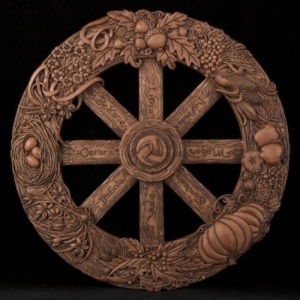The Celtic calendar focused on the cyclical change of seasons. The original Celts celebrated four fire festivals, evenly spaced throughout the year, celebrating the transition of the sun throughout the seasons. These include Samhain (Oct 31), Imbolc (Feb 1), Bealtaine (May 1), and Lughnasadh (Aug 1). These festivals are often combined with the solstices and equinoxes which are thought to be non-Celtic in origin, such as from Germanic Paganism or Neolithic sources. These ‘quarter festivals’ include Yule/Midwinter (c. Dec 21), Ostara (c. March 21), Litha/Midsummer (c. June 21), and Mabon (c. Sept 21).
Seasonal changes were very important to the agricultural Celts, who depended on the Wheel of the Year to dictate when to plow, sow, harvest, and rest. The turning of the Wheel represents the continuing birth, death and rebirth of nature.
Note: these dates correspond to the Northern Hemisphere.
SAMHAIN (October 31) (Cross-quarter, Fire Festival)
Samhain (SOW-in) represents the final harvest before the long winter. It’s a time to honor our ancestors and embrace the darker half of the year. This also marks the beginning of the New Year in many Pagan traditions.
YULE / MIDWINTER / WINTER SOLSTICE (December 20-23) (Quarter Festival, Solstice)
Yule marks the winter solstice, the shortest day of the year. From now on, the days become longer and we celebrate the return of the sun back to the earth. Also known as Alban Arthan (the Light of Arthur).
IMBOLC / CANDLEMAS (February 2) (Cross-quarter, Fire Festival)
Imbolc is a festival of fire and light, and in many Pagan traditions celebrates the Celtic hearth goddess, Brigid. It marks the midpoint between winter and spring. This is a festival of purification, a festival of light and fertility, and new beginnings.
OSTARA / SPRING EQUINOX (March 20-23) (Quarter Festival, Equinox)
Ostara is the celebration of the spring equinox, and is a time to prepare for the beginnings of new life each year. The hours of day and night are equal, and light is overtaking darkness. Also known as Alban Eilir (the Light of the Earth).
BEALTAINE / MAY DAY (May 1) (Cross-quarter, Fire Festival)
Bealtaine is a spring celebration that honours the fertility of the earth. A time of lust, passion, fire, and abundance.
LITHA / MIDSUMMER / SUMMER SOLSTICE (June 20-23) (Quarter Festival, Solstice)
Litha is the time of the Summer Solstice, the longest day of the year. It’s a celebration of light’s triumph over darkness and that of the bountiful beauty that light brings into our lives. Also known as Alban Hefin (the Light of the Shore).
LUGHNASADH / LAMMAS (August 1) (Cross-quarter, Fire Festival)
Lughnasadh (LOO-na-saa) is a celebration in honour of the Celtic god, Lugh. For others, this festival is observed as Lammas, and celebrates the early grain harvest. This is the first harvest festival, when plants drop their seeds to ensure future crops.
MABON / AUTUMN EQUINOX (September 20-23) (Quarter Festival, Equinox)
Mabon is a time of thanksgiving that celebrates the second harvest, and the autumn equinox. The days and nights are once again equal, with the night continuing to grow longer. Also known as Alban Elfed (Light of the Water).
PaganWiccanAbout.com
Wiki – Wheel of the Year
© The Celtic Journey (2013)



Can I use some of your info like the wheel on my website and in a blog if I reference your site?
Neville gardner http://www.donegalsquare.com, http://www.redstagpub.com
Sure thing! You might want to reference this page instead, its my other blog and has been updated a little:
thanks!